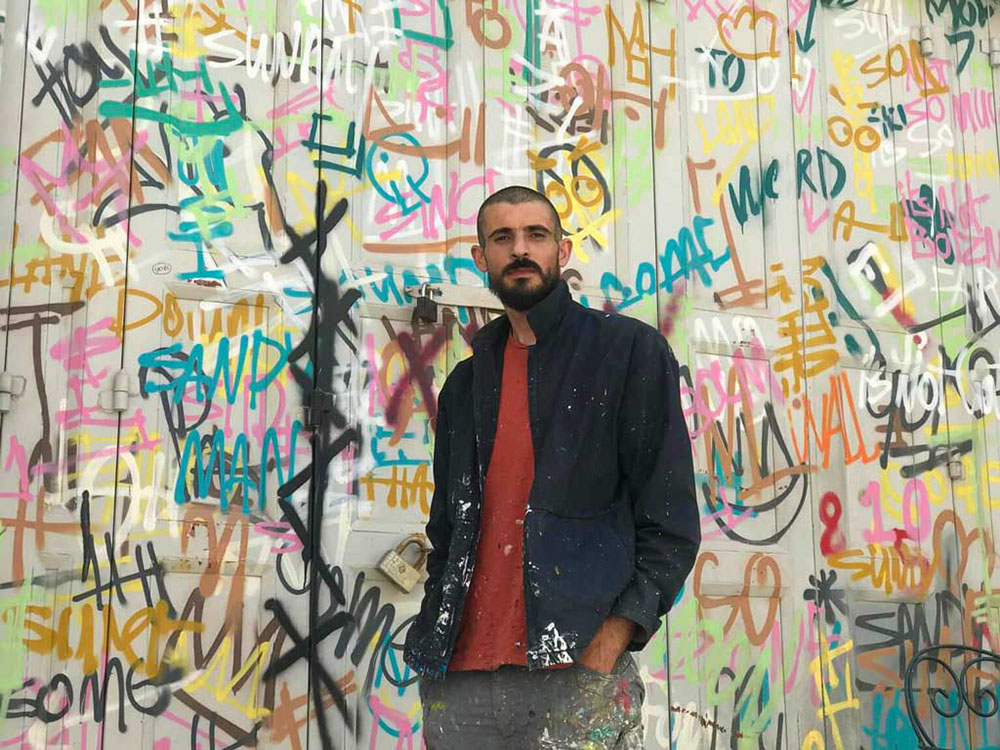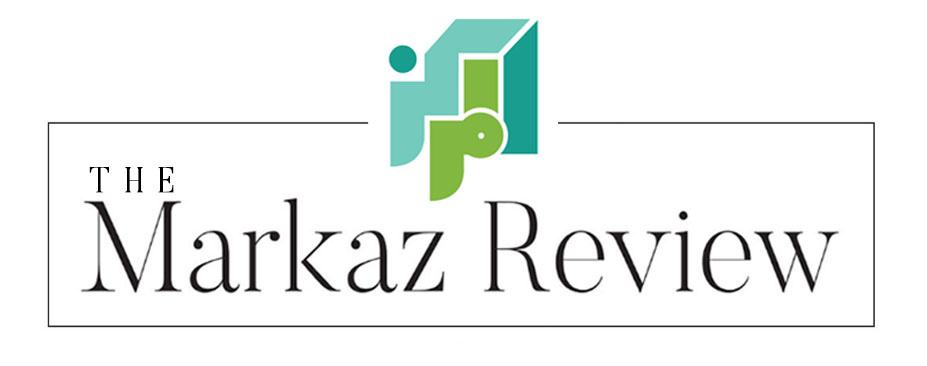The Bethlehem artist and activist Taqi Spateen painted the new Aaron Bushnell mural at the Palestine Museum in Woodbridge, Connecticut in just 48 hours.
Hadani Ditmars
The first American tour of Bethlehem-based artist Taqi Spateen is neatly bisected by the unveiling of a new mural at the Palestinian Museum U.S. in Woodbridge, Connecticut. The work was revealed on the July 4th weekend, the patriotic pomp of the holiday unfolding in sharp relief to Spateen’s portrait of the late Aaron Bushnell, the 25-year-old U.S. Airforce serviceman who self-immolated in front of the Israeli embassy in DC, on February 25, 2024, to protest his nation’s complicity in genocide. Through his dramatic act of self-sacrificing dissent, Bushnell became a hero to millions of people in Gaza and the West Bank, and around the world. Spateen’s moving portrait transforms the all-American New Englander into a Palestinian martyr.
Working with the iconic yet horrific image livestreamed on twitch of the young Bushnell burning himself alive as he shouted “free Palestine!”, Spateen says that he “changed fire to poppies,” by transmogrifying the line of flames in Bushnell’s immolation into poppies, which are the traditional Palestinian martyrs’ flowers. In the painting, the artist included his own children picking flowers and placing them on Bushnell’s body.
“I deliberately situated his body within a Palestinian landscape,” says Spateen in an interview with The Markaz Review. This could be interpreted as possibly the highest form of respect from a painter who intrinsically ties his people to their land, inexorably linking their identities. Palestine, says Spateen, is a kind of “paradise” where the “land sings.”
While Bushnell’s legs remain outside of the painted frame, “firmly planted outside the Israeli embassy in DC,” his body is “inside the frame of Palestinian history,” Spateen says.
The 6 x 17-foot portrait of a Christ-like Bushnell standing tall and saluting in the foreground surrounded by a panorama of green fields and urban scenes in eastern Gaza, looking West towards the Mediterranean Sea, is a striking reminder of his commitment to the cause. Where flames once licked his shoulders, poppies now embrace him, spilling down into the Palestinian soil, connected in a floral chain to the artist’s children.
“I wanted to show his humanity,” Spateen tells TMR of the piece that marks his first mural painted inside an art museum.
“Aaron was a hero who sacrificed himself for Palestine. He chose the most painful way to die — by fire. For me it is a way of honoring what he has done for Palestine. He is part of the history of people who supported Palestine. He gave his life for Palestine. It means everything.”

Spateen was in Jordan at the time of Bushnell’s death and said he was deeply moved by watching his story on TV. “Aaron’s body burned in solidarity with all the children, all the elders, who burned to death in their homes, in their tents, in their schools and hospitals,” he tells TMR. At the time he was inspired to paint his portrait in a similar style to his mural of George Floyd painted on the separation wall in Bethlehem who he says “was a victim of racism like us.” But it wasn’t until Faisal Saleh, the executive director of the Palestine Museum U.S., approached him last summer about painting a mural that the project came to fruition.
And yet, in contrast to the very graphic style employed by many mural artists, the work — like much of his oeuvre — owes more to the likes of Monet than Diego Rivera. His painterly love of landscape shines through every mural, infusing a classical sensibility into more mediatized Banksyesque street art themes. He eschews spray cans in favor of acrylics, and yet in contrast to his old school techniques, Spateen (a 2012 graduate of the International Academy of Arts in Ramallah) works at great speed.




“Amazingly,” Faisal Saleh tells TMR, “he produced the Bushnell mural in 48 hours.”
“Aaron Bushnell was a proud soldier with a deep conviction about his opposition to the Gaza Genocide,” says Saleh, “We honor his sacrifice and support for the Palestinian people in Gaza. His courageous act has sparked widespread outrage and solidarity with the Palestinian people.”
Saleh tells TMR that “We’d wanted to do something for Bushnell — who deserves to be commemorated — and Spateen whose work was featured in the museum’s 2022 Venice Biennale exhibition, seemed like the right person for the job.”
This permanent addition to the Palestine Museum U.S., situated in the main events hall, is in conversation with a portrait of another great American martyr for Palestine, Rachel Corrie, in an adjoining hall. The International Solidarity Movement member who was crushed by an Israeli armored bulldozer in Gaza in 2003 when she was protesting house demolitions, was commemorated in a 2018 work by Ayed Arafa — an artist from the Dheisheh refugee camp in Bethlehem.
Both Rachel Corrie and Bushnell, says Saleh, “were Americans who gave their lives for causes they believed in. And us being a museum in America, we thought it would be important and appropriate to create a memorial for these people.”
Bushnell is more relevant than ever, he says because “In the U.S., the corporate media has mispresented the reality on the ground in Gaza. They downplayed what Israel was doing in Gaza, pretending that there was full American support for Israeli actions. In fact, there are many Americans who don’t support genocide — as expressed now by demonstrations across the country and artists who speak out against it.”
But Bushnell, he says, was an early protestor. “When the media was totally pro-genocide, he was one of the first to speak out about it. And I thought it was very important to point out that there are Americans who don’t support the genocide, and that one of them was willing to give up his life for it. He refused to be complicit…by virtue of the work he was doing as an active member of the Air Force.”
As Spateen points out, he’s not celebrating self-immolation, but rather saluting Bushnell’s courage. “We need people who love Palestine to stay alive and resist.” A child of the intifada, who grew up throwing rocks at Israeli occupation soldiers, the 37-year-old artist describes painting as his new form of self defense. “My artwork is my resistance,” he says.
While Spateen has been invited to residencies and exhibitions throughout Europe and the UK since 2020, his first trip to the US, primarily as a guest of Chicago’s John David Mooney Foundation, has been a challenging one. “I feel the suffering of my people in Palestine while I’m inside the country that is the cause of that suffering,” he avows.
Spateen mentions an unfortunate incident in Chicago, where a large street mural he painted depicting a Mexican and Palestinian worker resting in a bucolic landscape — entitled “The nap after the fight” — was vandalized by a woman on June 13th. According to Spateen, she burned the face of the Palestinian and spray-painted “thank you Israel” across the mural. When a bystander tried to stop her, she allegedly beat her on the head with a metal hole puncher.
While Spateen says he was “not surprised that it happened,” he suggests it was “nothing” compared to what he experienced in Palestine. He was arrested and imprisoned twice by Israelis soldiers; once in 2021 in Bethlehem, after painting a mural depicting a battle between journalists and snipers — only a month before the murder of Shirin Abu Akleh. After painting a mural in 2023 on a street in Silwan — in East Jerusalem — a kind of tatreez fusion of landscape, embroidery and Palestinian families — he was arrested again, spent two days in jail and was fined 5,000 shekels for being “illegally” (as someone with a West Bank ID) in Jerusalem.
But Spateen remains defiant, telling TMR he is on a “mission” to counter stereotypes about Palestinians as either being “fighters with guns or passive victims.” During a 2022 residency in Paris, he recounts, he created 19 new paintings which he shipped to Palestine, where they were promptly confiscated by Israeli customs officials, who demanded $10,000 USD for their return. Spateen couldn’t afford to retrieve them so instead, he used his residency in Chicago to recreate them. They will be featured in an upcoming exhibition later this month at the JDM Foundation.
The artist, who also travelled to New Jersey and DC where he produced several community-painted murals and gave workshops and “teach-ins” on Palestine, says, “I have met many supporters in America.”
And while he says that people in the West Bank observing the carnage in Gaza are “waiting for our turn,” the meetings with sympathetic Americans “give me faith and hope for the future.”








